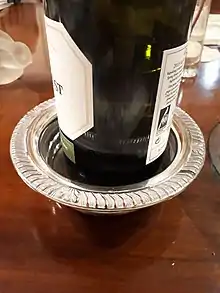Drink coaster
A coaster, drink coaster, beverage coaster, or beermat is an item used to rest drinks upon. Coasters protect the surface of a table or any other surface where the user might place a drink. Coasters placed on top of a beverage can also be used to show that a drink is not finished or to prevent contamination (usually from insects). Coasters can also stop hot drinks burning the table surface.

Pubs usually will have beermats spread out across their surfaces. They are used not just to protect the surface of the table, but, as they are usually made of paper, they can also be used to absorb condensation dripping along the glass or serve as an ad-hoc notebook. Beermats are often branded with trademarks or alcohol advertising. Beermats are not to be confused with bar mats, rectangular pieces of rubber or absorbent material used to protect the countertop and limit the spread of spilled drinks in a bar or pub.
History

The first coasters were designed for decanters or wine bottles, so that they could be slid (or "coasted") around the dinner table after the servants had retired. They were in common use after about 1760.[1] Early coasters took the form of a shallow tray or dish made of wood, papier-mâché, silver or silver plate.[2]
In 1880, the first beermats made of cardboard were introduced by the German printing company, Friedrich Horn.[3] In 1892, Robert Sputh of Dresden manufactured the first beermat made of wood pulp.[4] Watney brewery introduced them to the United Kingdom in 1920 to advertise their pale ale.[4] The packaging company Quarmby Promotions, established in 1872, began manufacturing beermats in Milnsbridge in 1931. After Quarmby Promotions was taken over by the Katz Group, it moved production to Brighouse and in 2006 to Morley, West Yorkshire, before closing its production in 2009.[5]
Saucers are also long used in western culture for much the same purpose. When drinking tea, it is customary to use a cup and saucer set. By the mid-twentieth century, drink coasters made in many materials and styles were being manufactured for domestic use. Today, they are common as an everyday houseware piece and are also used in restaurants.
Manufacture


Coasters are often made from high grammage paperboard, but may also be made from several layers of tissue paper. Important parameters for beer mats are water absorbency, wet rub and printability.[6][7][8]
More recently, glass coasters with empty frames have been produced. The consumer can then personalize each one with a different picture or design. More recently some beermat manufacturers have overhauled their manufacturing processes, allowing them to supply bespoke pulpboard beermats in quantities as low as 100 without significant price premiums associated with smaller print orders.[9] This has expanded the reach of the beermat with individuals choosing to have bespoke beermats printed for their wedding and political parties utilising them to deliver campaign messages.[10]
Coaster Factory and Canada Coaster, based in North America, and The Katz Group, based in Weisenbach, Germany, produce approximately 75% of the estimated 5.5 billion beermats in the world,[4] including about two-thirds of the European market and 97% of the US market.[3] In addition to the factory in Weisenbach, Katz has another two conversion factories in the U.S.: one in Sanborn, New York, and the other in Johnson City, Tennessee.[4]

Drink coasters are also made from soapstone, metal, wood and silicone.[11]
Some drink coasters can be recycled, and the United States Environmental Protection Agency lists the following as benefits of recycling:
- Conserves natural resources such as timber, water and minerals
- Increases economic security by tapping a domestic source of materials
- Saves energy[12]
Coaster imprints

Beermats are usually adorned with a customized image—usually mentioning or advertising a brand of beer, although they can also be used to promote a drinking establishment, sports franchise, businesses or special events.
Tegestology
Some coasters are collectible items. Tegestology is a term coined from Latin (teges, "covering" or "mat" and -etis) defined as the practice of collecting beermats or coasters, with practitioners known as tegestologists.[8] A 1960 British Pathé News short shows comedy duo Morecambe and Wise as tegestologists.[13]
References
 The dictionary definition of drink coaster at Wiktionary
The dictionary definition of drink coaster at Wiktionary Media related to Beermats at Wikimedia Commons
Media related to Beermats at Wikimedia Commons
- Cook, Peter (1988). The Antique Buyer's Handbook. McLaren Publishing. p. 97. ISBN 978-0947889258.
- Wills, Geoffrey (2015). Guide to Antique Collecting. CreateSpace Independent Publishing Platform. ISBN 978-1515311386.
- "Tough Times for the Humble Beer Mat". Spiegel Online. SPIEGELnet GmbH. 24 April 2009. Retrieved 26 May 2009.
- Atkinson, Simon (26 May 2009). "Last orders for beer mat maker?". BBC News. BBC. Retrieved 26 May 2009.
- Atkinson, Neil (1 December 2008). "Jobs lost as historic beer mat firm moves to Germany". Huddersfield Examiner. Trinity Mirror North West & North Wales Limited. Retrieved 26 May 2009.
- "Roller Coaster Manufacturers".
- "Custom Drink Coasters". Archived from the original on 5 November 2016. Retrieved 5 November 2016.
- Oxford English Dictionary (first citation 1960).
- "UK based Beermat manufacturer and printer". www.thirstys.co.uk. Retrieved 22 December 2017.
- "JD Wetherspoon issues Brexit beer mats". The Guardian. Press Association. 31 May 2016. ISSN 0261-3077. Retrieved 22 December 2017.
- https://cozyandtasty.com/collections/best-sellers/products/silicone-coasters-for-drinks-with-holder-set-of-6#shopify-product-reviews
- "How To Use Coasters To Protect Your Furniture". Coastal Coasters. 15 January 2019. Retrieved 21 June 2019.
- Morecambe And Wise (1960). YouTube. 13 April 2014.
